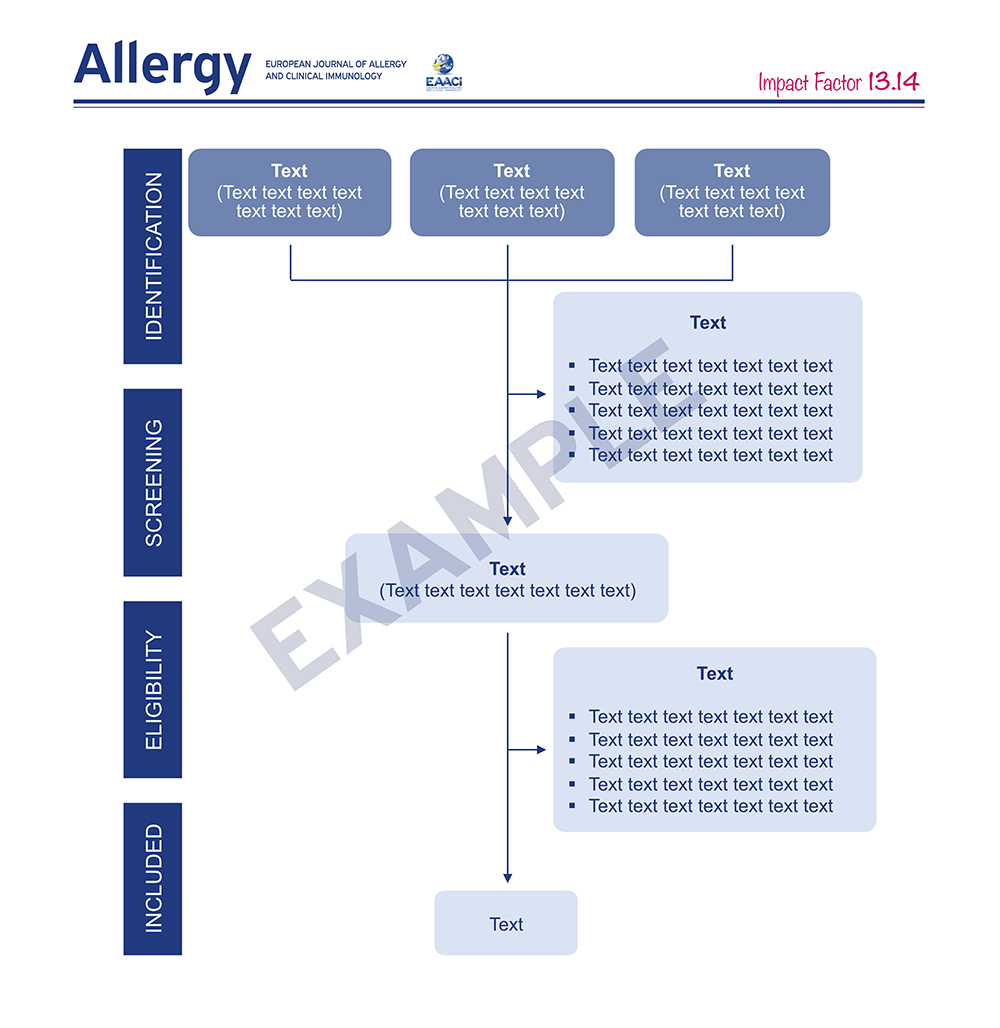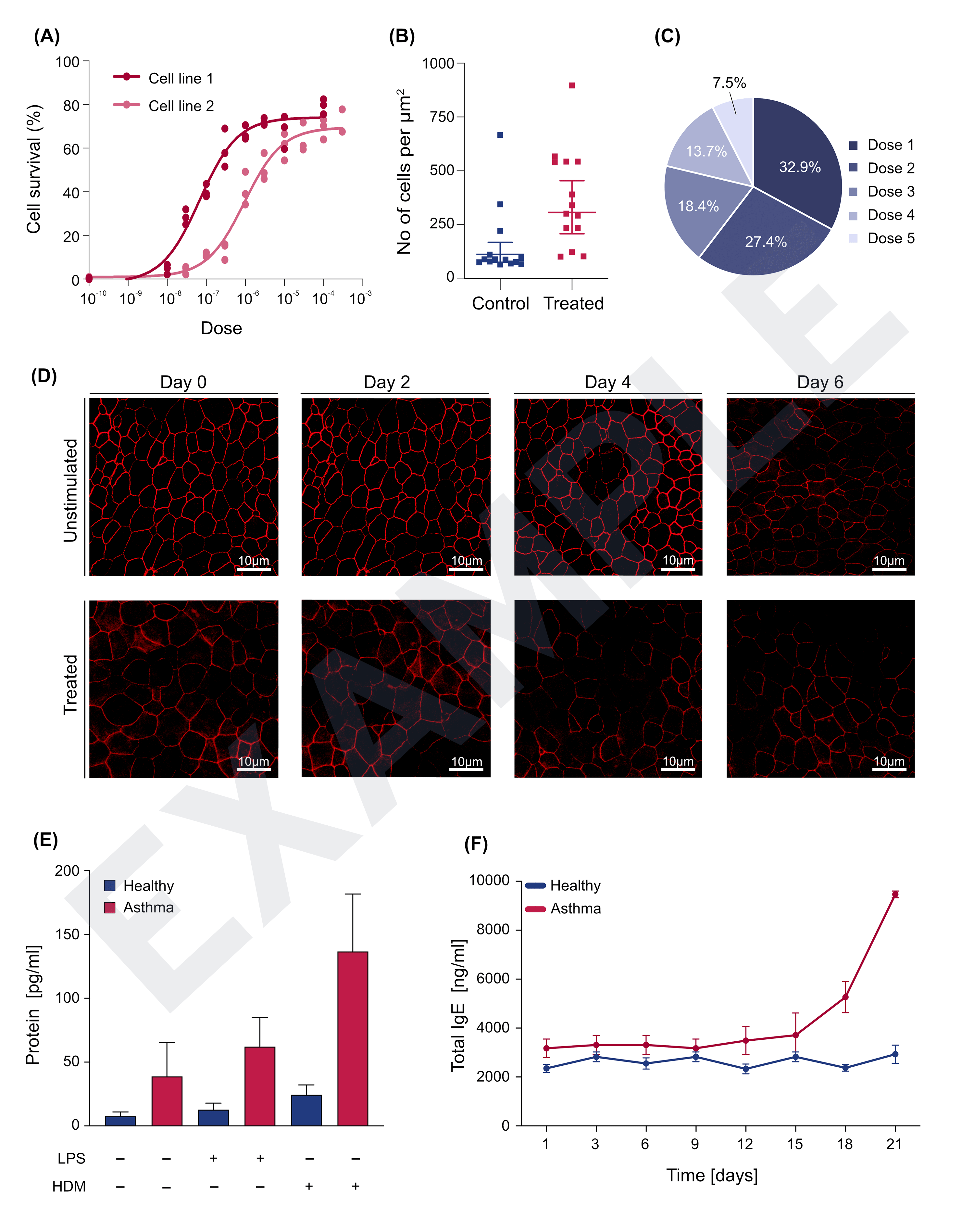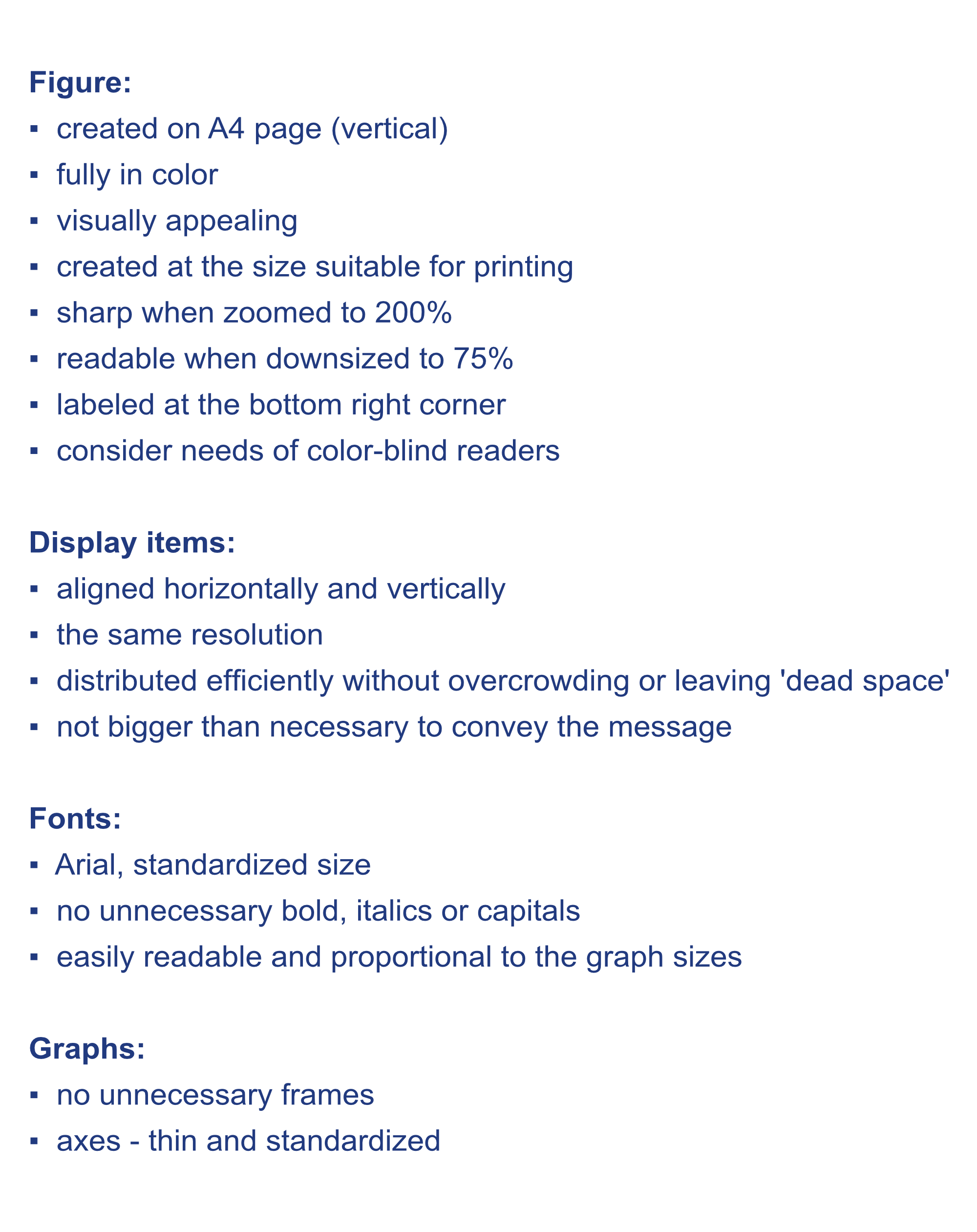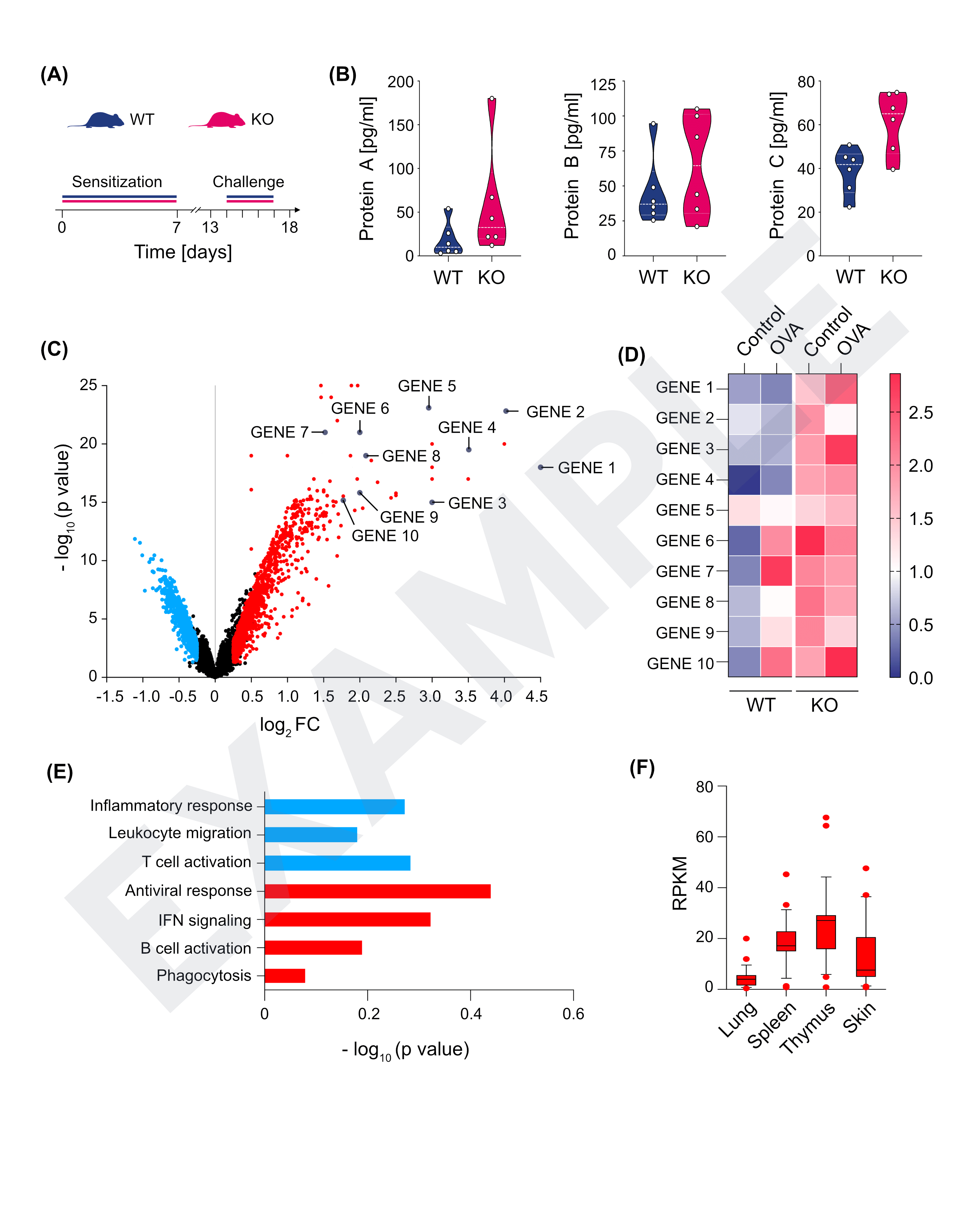Figure Guidelines
Here, we provide tools and guidelines for creating high-quality figures according to Allergy’s specifications. The following requirements apply to both, figures in the main manuscript and in the supporting information. To avoid publication delays, please review the instructions and check that your figures fully adhere to the journal’s specifications.
Before submitting the figures, please ensure that they meet the requirements below:
-
Figure is created on white background on an A4-size page (portrait orientation) with 15 mm margins on each side and allowing space below for the figure legend.
-
All display items are in color (does not apply to images that are originally black and white, e.g., immunoblots). There is no fee associated with colored figures.
-
Figure has minimum resolution of 300 dpi (initial submission) or 600 dpi (publication-ready), and remains sharp when enlarged to 200%.
-
Figure is prepared at the size you would expect it to appear in print.
-
Display items are aligned vertically and horizontally.
-
There is no dead space.
-
Text and labels are easily readable even when downsized to 75%.
-
Letters and numbers are in Arial or Helvetica font.
-
Figure panels (A), (B), (C), etc. are clearly indicated and labels do not overlap with the graphs/images/diagrams/heatmaps.
-
Each figure is labelled on the bottom right corner “Figure 1_Smith et al.”
-
Figure is submitted in one of the following formats: png, jpg, tiff, pdf.
-
Figure is created in RGB color palette.
-
Micrographs contain well-visible scale bar and their dimensions.
-
Algorithms, PRISMA diagrams and flow charts are prepared according to the Allergy Templates
To maximize the visibility of the data, Allergy has lifted the fee for color figures. When possible, graphs, plots, histograms, charts, diagrams and other display items have to be submitted in color.
-
Avoid colors that do not reproduce well (e.g., black or very dark background is not recommended – does not apply to e.g., confocal images)
-
Ensure sufficient contrast between text and its background (e.g., yellow font on white background is not recommended)
-
Submit color figures in RGB color mode
-
Consider the needs of color blind readers using the simulators (red and green must not be used together):
--> Simulator 1
--> Simulator 2 -
Allergy recommends the following colors*:
#b35806 RGB (179,88,6)
#f1a340 RGB (241,163,64)
#fee0b6 RGB (254,224,182
#d8daeb RGB (216,218,235)
#998ec3 RGB (153,142,195)
#542788 RGB (84,39,136)
*Credits to: Brewer, Cynthia A., 200x. www.ColorBrewer.org, accessed 23.08.2021
-
If you need more colors, please consult color palette generators:
--> Color palette generator 1
--> Color palette generator 2
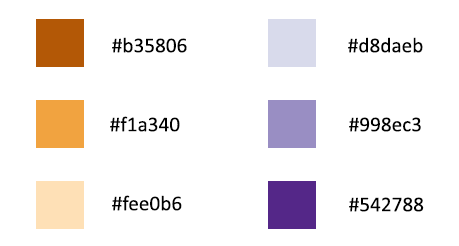
Figure format: Figures have to be submitted in one of the following formats: png, jpg, tiff, pdf. Please note: Our submission system does not accept PowerPoint files. Figures created in PowerPoint have to be converted to one of the acceptable formats. Each figure needs to be created on a separate A4-size page (portrait orientation) with 15 mm margins on each side and enough room below for the figure legend.
File size: Each individual figure file should not exceed 10 MB.
The quality of each figure should be checked by enlarging it to 200%. If the image appears fuzzy or jagged, the resolution is too low.
For the initial submission, Allergy requires the figures to have resolution of at least 300 dpi. Upon article acceptance or at the revision stage, authors will be asked to provide all the figures at the resolution of 600 dpi.
Please note: Artificially increasing an image’s resolution (setting the number of pixels to be higher than in the original image) using the artwork program will not improve image quality. Publication ready high-resolution figure can be obtained only if display items are exported from the data analysis software at high resolution (600 dpi).
Allergy requires figures to be submitted individually (eg. Figure 1.png, Figure 2.png, Figure 3.png), in the same order as they are referred to in the manuscript. Please ensure that each figure is mentioned in the text and in numerical order.
To facilitate publication, name figure files only with the word “Figure” and the appropriate number. For example: “Figure 1.png”
Please note: Our submission system does not accept PowerPoint files. Figures created in PowerPoint have to be converted to one of the acceptable formats.
Multi-paneled figures should fit on a single sheet of A4 paper (portrait orientation) with room for the figure legend.
Each panel should be indicated using bold capital letters in brackets, e.g. (A), (B), (C), (D), etc. Please make sure that labels are not overlapping with any part of the panel (e.g., placed directly on the display item).
Please do not upload each panel individually (e.g., Figure.1A.jpg, Figure.1B.jpg, Figure.1C.jpg). Multi-paneled figure must be submitted as a single file.
Font: Arial or Helvetica font should be used for the text inside the figures (applies to all labels, including graph axes). The same font sizes should be used for all figures. Greek letters should be added using the font Symbol. The text in the figures should be lower-case, with the first letter capitalized.
Font size: The text inside the figures should be easily readable when printed at A4 size. Font sizes, styles and typefaces should be consistent on all graphs. Using more than three different font sizes on the figure (including the graph axes) is strongly not recommended.
Text emphasis:
Bolding: Use bold font only to highlight the key information or draw attention to certain parts of the figure (e.g., avoid using bold for graph axes titles and scale labels).
Italics/capitalization: Italic font should only be used for certain Latin terms (e.g., Staphylococcus aureus), gene symbols (TGFB1), mRNA (TGFB1 mRNA), genotypes (TGFB1-/-). Protein symbols (e.g., TGF-β1) and gene names (transforming growth factor beta 1) should not be italicized.
Gene capitalization should follow the guidelines according to each species (e.g., TGFB1 - human gene symbol; Tgfb1 – mouse gene symbol).
Text color: Please ensure sufficient contrast between text and its background. Allergy recommends using black fonts on a white background.
A short figure title should be given as the first line of the legend. The title of a figure legend should describe the figure, in a clear and concise manner. The legend should contain enough information so that the figure can be understood in isolation from the main text. The word limit: 250 words.
Display items should:
-
be placed on a white background
-
fit on an A4-size page (portrait orientation) with 15 mm margins on each side and room below for the figure legend
-
be prepared at the size you would expect them to appear in print
-
be aligned vertically and horizontally
-
have consistent font: Arial or Helvetica; up to three different font sizes
Display items should not:
-
occupy bigger space than necessary to ensure readability
-
be framed
-
have three-dimensional or other decorative effects
-
be pixelated, fuzzy or jagged
Both reproduction and adaptation of previously published work requires the submission of copyright permissions. Redrawn figures do not require copyright permissions, nor do figures newly created using data from other publications.
Reproduction - example
Using a figure that has been previously published in exactly the same form.
Adaptation - example
Changing the previously published figure, for example by adding or subtracting information.
Allergy requires authors to obtain written permission from the copyright owner (for both the print and online format) for figures, tables, or text passages that have already been published elsewhere.
Please note that Graphical Abstract and Highlights have to be submitted only for Original Articles. Follow our detail guidelines available here: Graphical Abstract and Highlights
Please ensure that all the submitted illustrations meet the visual standards of Allergy. Authors are encouraged to create the figures using the graphics from the Free Allergy Graphics Collection.
13. Allergy Templates
Medical Algorithm: A step-by-step evidence-based protocol in the form of a decision tree that serves as a guide for the diagnosis and treatment of a disease.
Please adjust your Medical Algorithm to the journal’s style, using one of the templates below:

PRISMA Flow Diagrams: Graphical representation of the article selection process throughout the different stages of a systematic review. It outlines the number of studies included and rational for any exclusions.
Please adjust your PRISMA Flow Diagram to the journal’s style, using one of the templates below:
